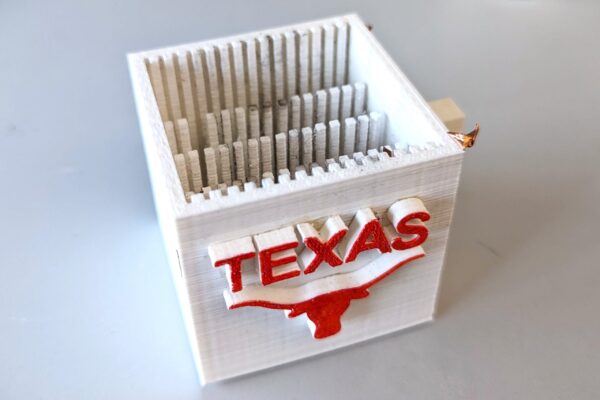Innovation is found each day at The University of Texas at Austin, and this year has been filled with world-changing ideas produced by Longhorns across all disciplines. Intergalactic discoveries, advancements in artificial intelligence and tools to combat climate change are just a few areas in which UT’s exemplary research efforts shined.
Explore the work of our faculty, students and researchers that stood out in 2023:
Brain Activity Decoder Can Reveal Stories in People’s Minds
With artificial intelligence growing rapidly, the College of Natural Sciences is at the forefront of one of its latest innovations: translating brain activity into words. A noninvasive method developed by researchers Alex Huth and Jerry Tang hopes to assist those mentally conscious yet unable to speak. Featured in The New York Times.

First Findings Shed Light on Role of Social Media Algorithms in 2020 Election
Four studies led by the Moody College of Communications’ Talia Stroud determined that Facebook’s role in shaping the American political beliefs of its users was influential but not directly altering during the 2020 election cycle. Featured in The New York Times.
Webb Telescope Detects Most Distant Active Supermassive Black Hole
The James Webb Space Telescope has allowed UT researchers to reach new heights in space discovery, including the ability to detect black holes from distances farther than ever previously possible. Featured in the Associated Press.

Water-Purifying Cup Makes Drinkable Water From Creeks and Streams
A 3D-printed prototype of a water purification device created by D. Emma Fan and a Cockrell School of Engineering team garnered intrigue from many with its ability to create drinkable water from ponds, streams and rivers by using electrodes to attract E. coli cells. Featured on KDFW-TV.
Cancer Drug Restores Immune System’s Ability to Fight Tumors
A new drug developed by researchers in the Dell Medical School, College of Natural Sciences and Cockrell School of Engineering has shown promise in restoring the effectiveness of immune cells in fighting cancer in animal models. The drug is designed to eliminate a toxic compound produced by cancerous cells, keeping the immune system strong. Featured on KXAN-TV.

Newly Discovered Jurassic Fossils Are a Texas First
Jackson School of Geosciences research led by Steve May resulted in the first discovery of a Jurassic vertebrate in Texas. Found in the Malone Mountains of West Texas, the weathered bone fragments proved to belong to a plesiosaur, an extinct marine reptile that resided in the area 150 million years ago. Featured in the Houston Chronicle. (May also recently named a rediscovered ancient beaver fossil after famed highway landmark Buc-ee’s.)
Scientists Detect Molten Rock Layer Hidden Under Earth’s Tectonic Plates
Research led by the Jackson School of Geosciences’ Junlin Hua revealed evidence of a previously undiscovered and hidden layer of soft rock at the bottom of the asthenosphere, an upper mantle of the Earth’s crust about 100 miles below the surface. Featured in CNN.
AI-Driven Earthquake Forecasting Shows Promise in Trials
Using real-time seismic data paired with previous earthquakes, UT researchers trained an AI algorithm to identify statistical bumps, which it used over a seven-month trial period in China, to forecast 70% of earthquakes a week before they happened. Featured on KXAN-TV.
Smart Farming Platform Improves Crop Yields, Minimizes Pollution
A “smart farming” system developed by engineers is working to minimize the overuse of fertilizers as farmers attempt to prevent contaminating groundwater and creating harmful greenhouse gasses without decreasing crop yields. Featured in The Cool Down.
Fraudulent Covid Aid Drove Up U.S. House Prices, Report Says
A team in the McCombs School of Business which previously revealed widespread fraud using COVID-19 relief funds newly concluded that granted loans poured money into the housing market, driving up prices and contributing to inflation across the country. Featured in The Wall Street Journal.
Oil-Capturing Technology Offers 10x Improvement Cleaning Up Hazardous Spills
Technology recently developed by Cockrell School of Engineering researchers has the potential to clean up oil spills 10 times faster than currently possible. The design uses a dual-layer mesh roller coupled with an induction heating technique, supercharging the reaction that separates oil from water. Featured on KVUE-TV.

Astronomers Confirm Maisie’s Galaxy is Among Earliest Ever Observed
After being detected last summer by a team of researchers from the College of Natural Sciences, Maisie’s galaxy was confirmed to be one of the four earliest galaxies ever observed. About 13.4 billion years old, Maisie’s galaxy was named after the daughter of head researcher Steven Finkelstein. Featured in Gizmodo.
Chest E-Tattoo Boasts Major Improvements in Heart Monitoring
UT engineers built on previous e-tattoo technology developed in 2022 with the utilization of wearable medical devices monitoring heart conditions. The technology is made up of an ultrathin, lightweight electronic tattoo that attaches to a patient’s chest for regular monitoring. Featured in U.S. News & World Report.
Vulnerable Neighborhoods Bore Brunt of Pandemic Well into its 2nd Year
UT’s Center for Pandemic Decision Science compared the harsh infection rates of COVID-19 in East Austin to the city’s wealthier neighborhoods in a study that determined that people in the most impoverished areas during the pandemic’s early months were up to 10 times more likely to contract COVID. Featured in KUT.
Llamas Help Mitigate Effects of Climate Change
Research stemming from the College of Liberal Arts showed that introducing llamas into land exposed by retreating glaciers can mitigate some of the harmful effects of climate change. The researchers partnered with the Llama 2000 Asociación, a local community of farmers in Peru whose village had been affected by acid rock drainage. Featured on KVUE-TV.





